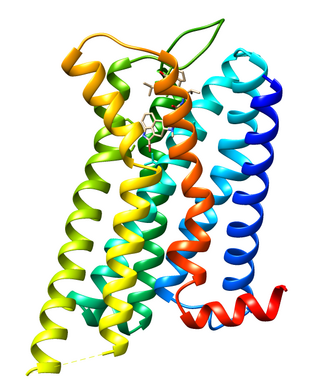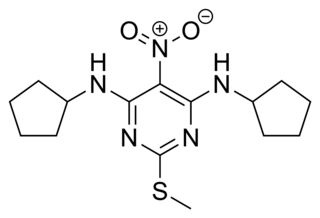
gamma-Hydroxybutyric acid is a naturally occurring neurotransmitter and a depressant drug. It is a precursor to GABA, glutamate, and glycine in certain brain areas. It acts on the GHB receptor and is a weak agonist at the GABAB receptor. GHB has been used in the medical setting as a general anesthetic and as treatment for cataplexy, narcolepsy, and alcoholism. The substance is also used illicitly for various reasons, including as a performance-enhancing drug, date rape drug, and as a recreational drug.
GABAB receptors (GABABR) are G-protein coupled receptors for gamma-aminobutyric acid (GABA), therefore making them metabotropic receptors, that are linked via G-proteins to potassium channels. The changing potassium concentrations hyperpolarize the cell at the end of an action potential. The reversal potential of the GABAB-mediated IPSP is −100 mV, which is much more hyperpolarized than the GABAA IPSP. GABAB receptors are found in the central nervous system and the autonomic division of the peripheral nervous system.
The GABAA-rho receptor is a subclass of GABAA receptors composed entirely of rho (ρ) subunits. GABAA receptors including those of the ρ-subclass are ligand-gated ion channels responsible for mediating the effects of gamma-amino butyric acid (GABA), the major inhibitory neurotransmitter in the brain. The GABAA-ρ receptor, like other GABAA receptors, is expressed in many areas of the brain, but in contrast to other GABAA receptors, the GABAA-ρ receptor has especially high expression in the retina.
GABA gamma-aminobutyric acid (GABA) is a key chemical messenger or a neurotransmitter in the central nervous system, that significantly inhibits neuronal transmission. GABA calms the brain and controls several physiological processes, such as stress, anxiety, and sleep. GABAA receptors are a class of ionotropic receptors that are triggered by GABA. They are made up of five subunits that are assembled in various configurations to create distinct receptor subtypes. The direct influx of chloride ions causes rapid inhibitory responses. GABAB receptors are another type of metabotropic receptor that modifies intracellular signaling pathways to provide slower, sustained inhibitory responses. At synapses, GABAA receptors facilitate rapid inhibitory neurotransmission, whereas GABAB receptor which comprise GABA B1 and GABA B2 subunits—control neurotransmitter release and cellular excitability over a longer period of time. These unique qualities help explain the various ways that GABAergic neurotransmission controls brain communication and neuronal function.

γ-Amino-β-hydroxybutyric acid (GABOB), also known as β-hydroxy-γ-aminobutyric acid (β-hydroxy-GABA), and sold under the brand name Gamibetal among others, is an anticonvulsant which is used for the treatment of epilepsy in Europe, Japan, and Mexico. It is a GABA analogue, or an analogue of the neurotransmitter γ-aminobutyric acid (GABA), and has been found to be an endogenous metabolite of GABA.

Dopamine receptor D2, also known as D2R, is a protein that, in humans, is encoded by the DRD2 gene. After work from Paul Greengard's lab had suggested that dopamine receptors were the site of action of antipsychotic drugs, several groups, including those of Solomon Snyder and Philip Seeman used a radiolabeled antipsychotic drug to identify what is now known as the dopamine D2 receptor. The dopamine D2 receptor is the main receptor for most antipsychotic drugs. The structure of DRD2 in complex with the atypical antipsychotic risperidone has been determined.

SB-277,011A is a drug which acts as a potent and selective dopamine D3 receptor antagonist, which is around 80-100x selective for D3 over D2, and lacks any partial agonist activity.

The 5HT6 receptor is a subtype of 5HT receptor that binds the endogenous neurotransmitter serotonin (5-hydroxytryptamine, 5HT). It is a G protein-coupled receptor (GPCR) that is coupled to Gs and mediates excitatory neurotransmission. HTR6 denotes the human gene encoding for the receptor.

Gamma-aminobutyric acid (GABA) B receptor, 2 (GABAB2) is a G-protein coupled receptor subunit encoded by the GABBR2 gene in humans.

Dopamine receptor D3 is a protein that in humans is encoded by the DRD3 gene.

Homotaurine is a natural sulfonic acid found in seaweed. It is analogous to taurine, but with an extra carbon in its chain. It has GABAergic activity, apparently by mimicking GABA, which it resembles.

The γ-hydroxybutyrate (GHB) receptor (GHBR), originally identified as GPR172A, is an excitatory G protein-coupled receptor (GPCR) that binds the neurotransmitter and psychoactive drug γ-hydroxybutyric acid (GHB). As solute carrier family 52 member 2 (SLC52A2), it is also a transporter for riboflavin.

GS-39783 is a compound used in scientific research which acts as a positive allosteric modulator at the GABAB receptor. It has been shown to produce anxiolytic effects in animal studies, and reduces self-administration of alcohol, cocaine and nicotine.

SKF-97,541 is a compound used in scientific research which acts primarily as a selective GABAB receptor agonist. It has sedative effects in animal studies and is widely used in research into potential treatment of various types of drug addiction.

CGP-35348 is a compound used in scientific research which acts as an antagonist at GABAB receptors.

Traxoprodil is a drug developed by Pfizer which acts as an NMDA antagonist, selective for the NR2B subunit. It has neuroprotective, analgesic, and anti-Parkinsonian effects in animal studies. Traxoprodil has been researched in humans as a potential treatment to lessen the damage to the brain after stroke, but results from clinical trials showed only modest benefit. The drug was found to cause EKG abnormalities and its clinical development was stopped. More recent animal studies have suggested traxoprodil may exhibit rapid-acting antidepressant effects similar to those of ketamine, although there is some evidence for similar psychoactive side effects and abuse potential at higher doses, which might limit clinical acceptance of traxoprodil for this application.

AFDX-384 (BIBN-161) is a drug which acts as a selective antagonist of the muscarinic acetylcholine receptors, with selectivity for the M2 and M4 subtypes. It is used mainly for mapping the distribution of M2 and M4 muscarinic receptors in the brain, and studying their involvement in the development and treatment of dementia and schizophrenia.

HA-966 or (±)-3-amino-1-hydroxy-pyrrolidin-2-one is a molecule used in scientific research as a glycine receptor and NMDA receptor antagonist / low efficacy partial agonist. It has neuroprotective and anticonvulsant, anxiolytic, antinociceptive and sedative / hypnotic effects in animal models. Pilot human clinical trials in the early 1960s showed that HA-966 appeared to benefit patients with tremors of extrapyramidal origin.

WB-4101 is a compound which acts as an antagonist at the α1B-adrenergic receptor. It was one of the first selective antagonists developed for this receptor and was invented in 1969, but is still commonly used in research into adrenergic receptors, especially as a lead compound from which to develop more selective drugs.

3-Aminopropylphosphinic acid, also known in the literature as 3-APPA or CGP 27492, is a compound used in scientific research which acts as an agonist at the GABAB receptor. It is part of a class of phosphinic acid GABAB agonists, which also includes SKF-97,541. It has a binding affinity (pKi) to the GABAB receptor of 8.30.

















